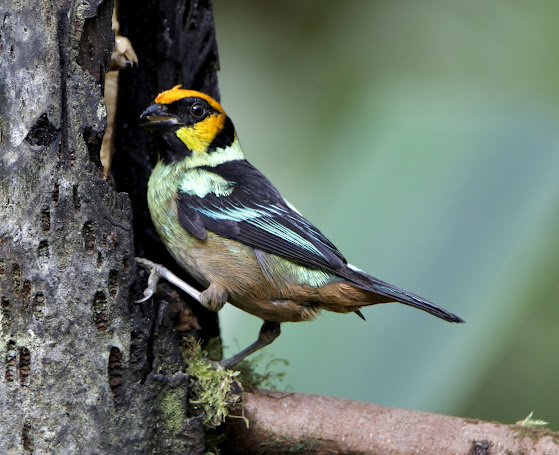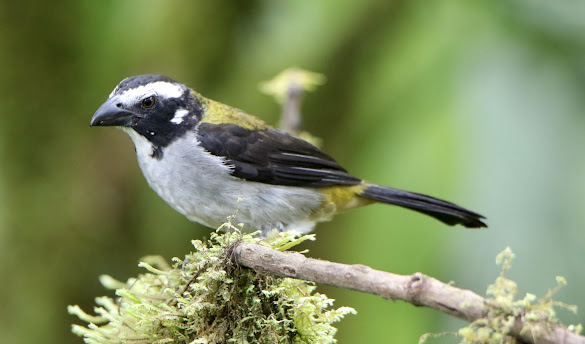MASHPI AND CUEVA DE LOS TAYOS
3/17/21
Today would be a full day of birding and we headed to the Mashpi Reserve, a place that has become well known since I was last in the country, which was 2009. We left at 05:00 but this time Javiar had a different driver. Cessil had gone to Quito to pick up someone at the airport quite late last night and was sleeping in, so the new drivers name was Melkay. He was younger, maybe mid 20s and quite funny, although he spoke no English. Often he would say something and Javiar would start laughing. It had rained early in the night, and when I went outside to meet them the stars were shining.
Up the hill we went to the main highway, and when we got upslope to Nanagalito, we took a left turn heading north. The road was paved and in good condition, but it had plenty of curves and hardly any straight parts. After the town of Pacto the road turned to gravel with the typical potholes, so traveling was now slower. It would take over and hour to get to our destination. Before reaching the Mashpi Reserve we encountered 2 recent landslides, but these were passable.
At the turn off for the reserve was an overlook, and the scenery was breathtaking.
 |
| The Mashpi Area is part of the larger Amagusa Reserve |
There were birds in the vicinity but they were simply not cooperating. We did hear a Black Solitare which was a very good bird for the area, and later we’d see a pair. The road was about a mile to the reserve center where they fed birds and provided coffee. It would be a slow walk there. It was all uphill for a few hundred meters, and when we got to the top we found a Moss-backed Tanager, my first lifer for the day.
We were fairly high in elevation, so at times the view was great:
Birding seemed slow but some of the ones we saw were: Wedge-billed Woodcreeper, Plumbeous Pigeon, Choco Daggerbill, Rose-faced Parrot (Lifer), Maroon-tailed Parakeet, Uniform Antshrike, Ornate Flycatcher, Cinnamon Becard, Choco Vireo (Lifer), Brown-capped Vireo, Three-striped Warbler, Black-winged Saltator, and Slate-throated Redstart.
 |
| Ornate Flycatcher |
The feeding area was very active with birds coming and going. Three other lifers were quick to come: Black-chinned Mountain Tanager, Glistening Green Tanager and Golden-collared Honeycreeper.
 |
| Moss-backed Tanager |
 |
| Rufous-throated Tanager |
 |
| Glistening Green Tanager. He is every bit as vibrant green as the picture shows |
 |
| Golden-collared Honeycreeper |
 |
| Black-chinned Mountain Tanager |
I think the rest of the tanagers were common ones we’d seen at other places, but the photographer in me simply had to capture their image as well.
 |
| One of the feeding areas. What color! |
 |
| A Flame-faced Tanager. Finally a photo in decent lighting |
 |
| Golden Tanager |
Before returning the mile back to the truck, we checked another feeding area about 50 meters away. A couple new ones for my trip here were Barred Becard and Black-billed Peppershrike.
The walk back was more productive than coming in. We actually were accompanied by the manager Sergio, and his wife joined us for the first 200 meters. The main bird which is more gettable here than elsewhere is the Indigo Flowerpiercer, and we’d not seen one as yet. Another gettable one was the Rufous-brown Solitare, which had been seen this morning by some other birders, and Sergio’s wife showed us where the most likely area was, but we could not relocate him.
One nice find along the way was a parent and young Uniform Treehunter.
 |
| Immature Uniform Treehunter |
Another very nice find were 2 different White-tipped Sicklebills, hummingbirds whose bill is shaped like a sickle and reaches about to the 90 degree bend, if you can imagine that.
About half way back Javiar spotted a male Golden-headed Quetzal perched as if he were posing for an ad in a nature magazine. Too bad he was not a little closer.
 |
| Golden-headed Quetzal |
Shortly after that two Masked Trogons came through, one staying long enough to get his picture taken. I could not decide which photo was better so I included both:
 |
| Masked Trogon |
 |
| Masked Trogon |
A Black-winged Saltator came in close as well:
 |
| Black-winged Saltator |
Javiar and Sergio both turned around at the same time, having heard an Orange-breasted Fruiteater. I heard it also, and knew what it was from the day before after playing his song a few times. We ended up following him from tree to tree and he eventually was joined but another male and a female of the same species. But none of them ever gave me a decent opportunity to take his pic
 |
| Orange-breasted Fruiteater |
When we were nearing our vehicle, and after much playing of his song, an Indigo Flowerpiercer finally made an appearance. We did not get a very good look at it, and we could also tell he was indeed that species when he repeated the song we’d been playing for the last half hour.
On the final stretch going down the hill we were graced by 2 Black Solitares, and the best view we were allowed was of one flying across the road. While we were trying to get it to return by playing his song, I saw another Indigo Flowerpiercer, but still not a great look. One last bird of interest was a Squirrel Cuckoo who also flew across the road, not the best look either.
We headed back toward civilization and stopped at the town of Pacto for lunch. It was around noon, and we were pretty hungry not having had breakfast. Then it was off to the hamlet of Al Chontal, somewhere to the north (I think). In short order we ran out of pavement, and it was a one hour drive on gravel roads full of potholes. The landscape was hilly and we were always going up and down and around curves. What forest was seen was all 2nd growth and higher up in more inaccessible areas, and the rest was planted in sugarcane, coffee or aloe vera or was pasture for cows.
We finally descended to a large river valley, and the river was really flowing with muddy water. On the other side of the bridge was the small village of Al Chontal, but we needed to go right, upriver to reach our destination. On the way I spied a Masked Tityra sitting out in the open.
 |
| Masked Tityra |
In a mile we headed up a steep driveway to a house, and inquired if the Senor was home. He was not, so a young boy came with us to open the gates. We drove back to the road, went a few hundred yards to a locked gate, opened it up and drove to the bottom of the hill where we parked and walked over to another locked gate.
Past the gate a cement walkway led into a rocky ravine with a rushing stream running through it. We had reached the “Cueva de los Tayos,” or, Oilbird Cave. A colony of about 20 birds reside here year round, nest and raise their young as well.
Oilbirds are the only species of their kind in the genus of Steatornis, and are related to the nightjar family. They are about 18 inches long. They are nocturnal and leave their caves or ravines only at night and can fly long distances to feed. They eat fruit, especially of the oil palm and are responsible for the dispursement of the seeds of many tropical fruits. While they forage at night with adapted eyesight, they navigate by ecolation in the same way as bats. However, some birds roost at night in the jungle. They can be quite noisy as well. Apparently they don’t exit their caves when people enter them, but fly around inside until returning to a small ledge.
 |
| Oilbird - Copied from Wikipedia |
The name “Oilbird” refers to the young birds, who before fledging, weigh about 1/3 to 1/2 again as much as the adults because of the fat accumulation. Early Spanish monks and others occasionally procured a young bird to render it down into cooking oil. The adults raise 2-4 young.
 |
| Oilbird |
We only needed to go about 75 feet to where the colony of about 20 Oilbirds reside. At the end of the pathway was a wider cement floor with rails from which you could see the birds. They were scattered around the walls of the rocky ravine resting on small ledges. Some were a little agitated by our presence and would occasionally fly around within the confines of the area, emitting a guttural, squawking, growling type of noice.
This was a really fascinating and fun experience, and I wish I could describe it better, but you just had to be there for that. I tried to take pictures with my long lens, but it was just too dark. So I obtained some pics with the iPhone through the lens of Javiar’s scope, and those will have to do, but I did add one pic from Wikipedia.
Then it was back to the return journey. Another hour of riding on the poor roads. We did located a pair of Smooth-billed Anis and Hook-billed Kites along the way, as well as a Choco Toucan, but otherwise the rest were the common seedeaters, Tropical Kingbirds, and vultures.








No comments:
Post a Comment